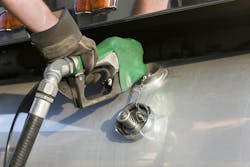Fuel theft is an age-old problem for commercial fleets. What started as filling non-approved vehicles with company funds has now taken on various forms: card skimming, fuel siphoning, misuse of company cards, mileage creeping, and more. As global tensions escalate across the world, fleets may be holding their breath as gas prices become more volatile. Fuel is a universal currency, so naturally, as gas prices rise, so does the risk of fuel theft. While each instance may seem small, these illegal activities add up.
According to Motive's Physical Economy Outlook 2024, the trucking and logistics leader estimated 14% of fleet payments were lost to fraud or theft. At the enterprise level it was 19%, and 16% for small fleets. This is quite a large percentage of a fleet’s budget, not to mention the administrative lift for tracking and investigating incidents. But even as the avenues for fuel theft get more and more creative, it is possible for fleet managers to prevent these types of fraud.
Identify and track internal and external threats
When looking at fuel theft, there are numerous avenues of how it’s taking place, so tracking it can seem a daunting task. But with the right resources and data, it doesn’t have to be.
Card skimming is likely the first thing that comes to mind when talking about fuel theft. This is a form of credit card fraud that doesn’t leave just truck drivers vulnerable to theft, but anyone who stops at a gas station to fuel up. Card skimming is almost always an external threat, involving an illegal device installed at the fuel pump to steal credit card information. Spotting card skimmers can be difficult, as they are not clearly visible upon a routine fill-up.
One of the best ways to avoid skimming would be to issue fuel cards that can provide enhanced security by enforcing the use of a driver ID/PIN at the time of purchase. Fuel cards also offer the ability to set spending limits by day, time, and even location. Having a trusted technology partner to supply fuel cards and spending data, like FLEETCOR, is key to accurately tracking fraudulent activity.
One of the oldest forms of fuel theft is fuel siphoning, which involves the act of physically removing gasoline or diesel from a vehicle. This is particularly common for work trucks, as their routes tend to be more predictable and they could often be parked in rural areas with less risk of being seen. Physical barriers, such as locked fuel caps and anti-siphoning devices can help alleviate this risk. Combined with a software solution that can link to fuel sensors and alert to siphoning in real-time, fleets can successfully mitigate the threat of siphoning.
Read more: Shell TapUp's mobile fueling optimizes fleets' downtime, prevents theft
But fuel theft is not always a malicious act from a third party. In fact, internal fuel theft is more commonly seen, often due to misuse of company credit cards. When drivers use fleet cards for personal use, that cuts into the overall fuel budget, and these little things like food, drinks, or car washes can really add up.
When done with ill-intention, this is called “slippage," and the purchases are reported by drivers as a legitimate fuel purchase. Though they are not always aware that what they’re doing is illegal, drivers should be educated on exactly what their fuel cards should be used for.
Another form of misuse includes using fleet money to fill either a container or a driver’s personal vehicle, known as “side fueling.” Fuel cards, backed by advanced AIoT (Artificial intelligence of Things) software and vehicle telematics, are an excellent resource to proactively identify and eliminate fraudulent driver purchases. With this technology, fleet managers can subscribe to receive notifications that flag these suspicious activities and run reports that summarize all activity surrounding fuel purchases.
Solutions like Powerfleet’s Unity platform and Advanced Fuel Management data-powered application can provide real-time identification of fuel fraud through monitoring events and fuel card integration by matching consumption trends, gas station locations with gas-filling, and sudden drops in fuel tanks.
AIoT software can also provide the data needed to easily uncover other hidden costs and losses, such as vehicle usage in off-business hours/days and driver behavior that negatively impacts fuel economy. This is especially helpful for uncovering another internal fuel theft tactic known as “milage creeping”, in which drivers inflate mileage numbers. For avoiding all types of fuel theft, data is king.
Remain vigilant and utilize education
To significantly minimize fuel theft from both internal and external threats, the key is to remain vigilant and ensure drivers are educated on what to look out for. With the proper knowledge, fleet operators can more easily spot signs of theft and fraud, know exactly what the conditions of their fuel cards are, and rules will be top of mind when frequently enforced.
By utilizing advanced technology and keeping drivers informed, your fleet will have a significant advantage in terms of efficiency, performance, and fuel consumption, down to the mile.
Eric Frey is director of Global Product Management for Connected Vehicles & IoT at Powerfleet.
About the Author

Eric Frey
Director of Global Product Management for Connected Vehicles & IoT
As director of Global Product Management for Connected Vehicles & IoT at Powerfleet, Eric Frey is responsible for managing the vehicle product line solutions and overall sales enablement in the connected vehicle space. Since joining the company in 2006, Eric has held management and leadership roles in software development, pre-sales and solutions engineering, and product management. Eric holds a BSc in Computer Science from Stevens Institute of Technology and is a certified product manager from the AIPMM.

